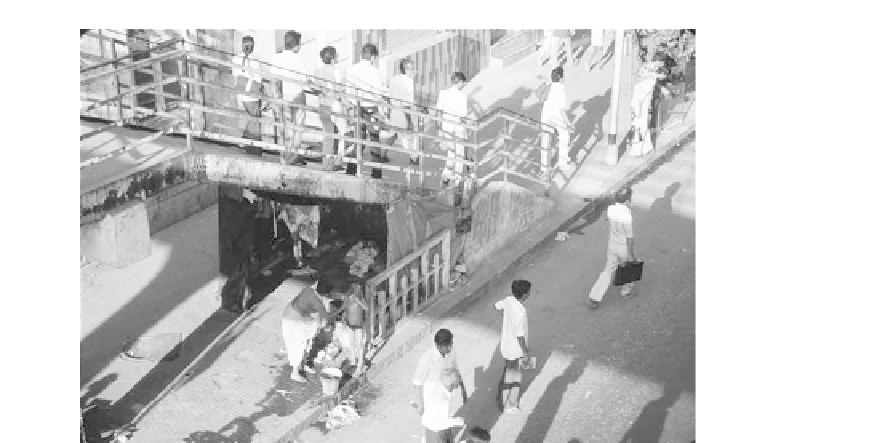Geography Reference
In-Depth Information
Figure 4-7
This family lives under a pedestrian overpass over
a railroad line in Mumbai. This is an excellent
location as it is sheltered and near a public
“standpipe”—a water tap. Also, the family can
scavenge the tracks for food such as banana skins
that are thrown out of the train windows by mid-
dle-class commuters.
Photograph courtesy of
B. A. Weightman.
8 percent of Manila' s slum residents remain uncounted.
Moreover, slum populations do not include millions of
pavement-dwellers who have no permanent home at
all. Entire families, mostly in South Asia, seek shelter in
railroad stations, under overpasses, in doorways, in
parks, in alleys, or they simply lie down on the sidewalk
(Figure 4-7).
Slum space has become commodified. For instance,
the majority of slum dwellers in Bangkok actually rent
the land where they build their shacks. In India, people
who prop their shanties against high-rise apartment
blocks pay rent to building or apartment owners. Land-
lordism is a fundamental and divisive social relation in
the slum world. Already-poor slum dwellers rent to
poorer slum dwellers and have no qualms about ousting
those who can't pay . Even pavement-dwellers must pay
someone for their space.
Slum communities continue to grow in scope and ex-
tent although most governments have tried to get rid of
them. Consequently , there is a never-ending social war
against the urban poor in the name of “beautification,”
and even “social justice for the poor.” Persistent slum-
clearance operations in Delhi, designed to create space for
middle-class subdivisions, have produced endless cycles
of settlement, eviction, demolition, and resettlement.
The most intense battle occurs in downtowns and
major urban nodes. Globalized property values collide
with the desperate need of the poor to be near central
sources of income. Officials may redraw spatial bound-
aries to the advantage of landowners, foreign investors,
elite homeowners, and middle-class consumers. The
urban poor are a type of nomad—transient in a perpetual
state of relocation.
Some cities such as Mumbai and Delhi have built
satellite cities to encourage the poor to move from more
valuable land nearer to the city centers. These new , per-
ceptibly advantageous locations have emerged as magnets
for rural-urban migrants and middle-class commuters.
Squatters, renters, and even low-level landlords are sum-
marily evicted without compensation or right of appeal.
It is poor city dwellers that many elite and middle-
class groups consider to be the population “them,”
“those people,” “the problem.” Or they deny their exis-
tence altogether. (This attitude is confirmed by several
Indian authors.)
I once had an Indian student in my Geography of
Asia class who insisted that there was no poverty in
India. When Geeta saw my slides she was appalled and
couldn't believe what she was witnessing. She told me
that she only left her (rich) family compound in Delhi in
a chauffeured limousine with its windows blackened to
keep “them” from looking in. The bulk of her outings
were to private school, fancy malls, or social functions in
luxury hotels. After a semester break back in Delhi,
Geeta came to see me. She told me that she had never re-
ally looked at the landscape around her and that once she
realized some of its realities, she tried to talk about them
with her parents. Her mother told her that, “We don't
discuss such things.”
WHO considers road traffic one of the worst health
hazards facing the urban poor and predicts that road
accidents will be the third leading cause of death by

















Search WWH ::

Custom Search